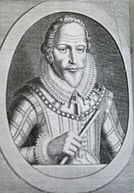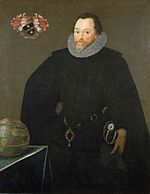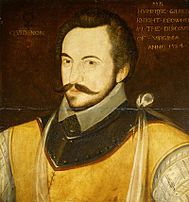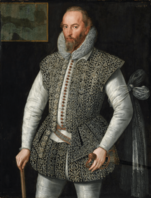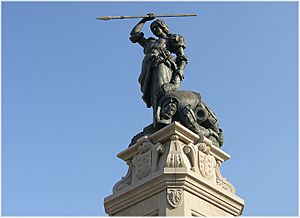Elizabethan Sea Dogs facts for kids
The Sea Dogs were a group of English privateers and explorers. Queen Elizabeth I gave them permission to attack England's enemies. They did this even when England was not officially at war.
These brave sailors were active from about 1560 until the Queen's death in 1603. The Sea Dogs mostly attacked Spanish ships and towns. This was especially true during the Anglo-Spanish War. Some famous Sea Dogs, like Sir John Hawkins and Sir Francis Drake, were also involved in the Atlantic slave trade with Spanish colonies in the Americas.
Who Were the Sea Dogs?
"Sea Dogs" was a nickname for English privateers. Queen Elizabeth I gave them special permission to raid England's enemies. They could do this even during times of peace.
They carried special documents called letters of marque from the English Crown. These letters allowed them to attack enemy ships at sea and enemy bases on land. England's navy was not as big as Spain's at the time. So, these letters helped England attack Spanish ships even when there was no war.
After Queen Elizabeth died in 1603, many Sea Dogs looked for new work. Some became corsairs in the Barbary States. They then attacked European merchant ships.
Famous Sea Dogs
John Davis (1550–1605)
John Davis was an English explorer and navigator. He made several voyages to find the Northwest Passage. This was a sea route through North America. He also explored parts of the Arctic.
Sir Francis Drake (1540–1596)
Sir Francis Drake was one of the most successful Sea Dogs. He sailed for the English navy from 1563 to 1596. He became a high-ranking officer. His cousin, Sir John Hawkins, trained him for a life at sea.
Drake was the first Englishman to sail around the world. This amazing journey started in 1577 and ended in 1580. He raided Spanish areas all the way up the Pacific Coast. He even reached what is now San Francisco.
Drake also sailed into ports in the Caribbean. He would demand money from cities. If they didn't pay, he would start burning parts of the city. Queen Elizabeth made him a knight in 1581. He later died from an illness after trying to capture San Juan, Puerto Rico.
Sir Martin Frobisher (1535–1594)
Sir Martin Frobisher was a skilled seaman and privateer. He made three trips to the New World. He was searching for the Northwest Passage. As a privateer, he captured valuable goods from French ships. He was made a knight for his help in fighting off the Spanish Armada in 1588.
Sir Humphrey Gilbert (1539–1583)
Sir Humphrey Gilbert went to famous schools like Eton College and the University of Oxford. He was involved in establishing English settlements in Ireland. He was also the first to claim land in North America for England. He took possession of Newfoundland for Queen Elizabeth I in 1583. He was the half-brother of Sir Walter Raleigh. He was also a cousin of Sir Richard Grenville.
Sir Richard Grenville (1542–1591)
Sir Richard Grenville owned large estates in Cornwall and Devon. He helped establish English settlements in Ireland and North America. He also helped fight off the Spanish Armada. In 1591, Grenville died at the Battle of Flores. He was fighting a much larger Spanish fleet near the Azores.
He and his crew on the ship Revenge fought bravely. They battled 53 Spanish ships. This allowed other English ships to escape. Grenville's grandson, Sir Bevil Grenville, became a famous military officer.
Sir John Hawkins (1532–1595)
Sir John Hawkins came from a wealthy family. His father was a sea captain. Hawkins first sailed with his father on trading trips. By 1562, he became involved in the Atlantic slave trade. He used his ships to transport enslaved Africans. He sold them in the Spanish West Indies.
He was involved in this trade for about five years. He made three voyages to Sierra Leone and Guinea. He transported many enslaved Africans to Spanish colonies. He later became the Treasurer of the Navy. He helped make many improvements. He died in 1595 near Puerto Rico. This was during a failed attempt to rescue his son, Richard.
Sir Richard Hawkins (1562–1622)
Sir Richard Hawkins was the son of Sir John Hawkins. He followed in his father's footsteps as a sailor and explorer. He made his own famous voyage around the world. He was captured by the Spanish during his travels.
Sir Walter Raleigh (1552–1618)
Sir Walter Raleigh was a favorite of Queen Elizabeth. She gave him permission to claim any new land he found for England. On a trip to the New World, he started the Roanoke colony. This colony later disappeared.
Raleigh became very interested in finding a "city of gold" in South America. He went on an expedition to find this city, called "El Dorado". On his second trip, his men attacked a Spanish outpost. This was a problem because England and Spain were at peace.
After this, Raleigh returned to England. The Spanish were very upset about what his men had done. To make peace, Raleigh was later executed during the reign of King James VI and I.
Sea Dogs and the Spanish Armada
After years of English Sea Dogs raiding Spanish ships, Philip II of Spain decided he had had enough. King Philip II gathered a huge fleet of 130 ships. He planned to sail into the English Channel and stop English sea raids for good.
On May 28, 1588, the Armada set sail. It was led by the Duke of Medina Sidonia. The fleet was heading to the Netherlands to pick up more soldiers. These soldiers would then invade England.
As the Armada sailed through the English Channel, the English navy fought them. The English ships were led by Charles Howard, 1st Earl of Nottingham and Francis Drake. They fought the Spanish from Plymouth to Portland and then to the Solent. The English stopped the Spanish from taking any English harbors.
The Spanish were forced to go to Calais. While they were anchored there, the English used fireships. These were ships set on fire and sent into the Spanish fleet. This broke up the Spanish formation and scattered their ships. Spanish ships were bigger and had more weapons. But English ships were smaller, faster, and could move better.
In the next battle, called the Battle of Gravelines, the English navy defeated the Armada. They forced the Spanish to sail north into dangerous, stormy waters to get home. As they sailed around Scotland, the Armada was badly damaged by storms. Many ships were lost. More storms hit them near the west coast of Ireland. Many more ships were wrecked. Disease also spread through the fleet. Finally, the remaining ships limped back to port. More than half of their original ships were lost.
Philip's invasion failed partly because of bad weather and his own mistakes. But it also failed because the English and their Dutch allies fought bravely. The defeat of the Armada gave English sailors valuable experience at sea. The English continued to raid the Spanish. They also sent troops to help Spain's enemies in the Netherlands and France.
Many people saw the Armada's failure as a sign that God supported the Protestant faith in England. A medal made to celebrate the English victory had a Latin phrase on it. It meant: "He blew with His winds, and they were scattered".
An English counter-attack was planned in 1589. It was led by Sir Francis Drake and Sir John Norreys. The goal was to destroy the Spanish navy. The Spanish ships were being repaired in northern Spain. The English also hoped to capture the incoming Spanish treasure fleet. They also wanted to remove the Spanish from Portugal.
The English fleet left Plymouth on April 13. But bad weather delayed them for almost two weeks. Because of this, Drake had to skip Santander. Most of the Spanish fleet was being repaired there.
On May 4, the English arrived at Corunna. They captured and looted the lower town. They also seized several merchant ships. Norreys won a small victory over a Spanish relief force. But when the English attacked the main fort, they were pushed back. Some English ships were also captured by the Spanish navy.
Since they failed to capture Corunna, the English sailed towards Lisbon. But because of poor planning and lack of coordination, they also failed to take Lisbon. The people of Portugal, who were expected to rise up against Spain, never did. With Spanish and Portuguese soldiers arriving, the English retreated. They headed north and Drake attacked and burned Vigo.
Then, sickness spread through the expedition. Finally, a part of the fleet led by Drake went towards the Azores. But a storm scattered them. Drake then took the best part of the fleet and looted Porto Santo in Madeira. Then they slowly returned to Plymouth.
The English Armada was not well planned and ended in failure. Queen Elizabeth's treasury lost a lot of money.


